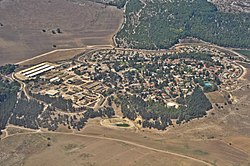Megiddo, Israel
|
Megiddo מְגִדּוֹ, מגידו |
|
|---|---|

Aerial view of Megiddo from the east.
|
|
| Coordinates: 32°34′44″N 35°10′50″E / 32.57889°N 35.18056°ECoordinates: 32°34′44″N 35°10′50″E / 32.57889°N 35.18056°E | |
| District | Northern |
| Council | Megiddo |
| Affiliation | Kibbutz Movement |
| Founded | 7000 BCE (Canaanite city) 1150 BCE (Israelite city) 1949 (modern kibbutz) |
| Founded by | Holocaust survivors |
| Population (2015) | 847 |
| Website | www |
Megiddo (Hebrew: מְגִדּוֹ، Arabic: المجیدو) is a kibbutz in northern Israel. Located in the Jezreel Valley, it falls under the jurisdiction of Megiddo Regional Council. In 2015 it had a population of 847.
The kibbutz is located near Megiddo Junction, the intersection of highways 65 (from Hadera to Afula) and 66 (running from Haifa south to the West Bank). The junction is the site of a bus terminal and a high-security prison. In Christian apocalyptic literature, Mount Megiddo, the hill overlooking the valley where the current kibbutz is located, is identified as the site of the final battle between the forces of good and evil at the end of time, known as Armageddon and mentioned in the New Testament in Revelation 16:16.
Tel Megiddo is considered one of the most ancient settlements in the Middle East. It guarded the western branch of a narrow pass and trade route connecting Ancient Egypt and Assyria. The site was inhabited from approximately 7000 BCE to 586 BCE though the first significant remains date to the Chalcolithic period (4500–3500 BCE). However, the town experienced a decline in the Early Bronze-Age IV period (2300–2000 BCE), but the city was somewhat revived around 2000 BCE. Following massive construction, the town reached its largest size in the Middle Bronze-Age, at 10–12 hectares. Though the city was subjugated by Thutmose III, it still prospered, and a massive and incredibly elaborate palace was constructed in the Late Bronze Age.
The city was destroyed around 1150 BCE, and the area was resettled by what some scholars have identified as early Israelites, before being replaced with an unwalled Philistine town. When the Israelites captured it, though, it became an important city, before being destroyed, possibly by Aramaean raiders, and rebuilt, this time as an administrative center for Tiglath-Pileser III's occupation of Samaria. However, its importance soon dwindled, and it was finally abandoned around 586 BCE. Since that time it has remained uninhabited, preserving ruins pre-dating 586 BCE without settlements ever disturbing them. Instead, the town of Lajjun (not to be confused with the el-Lajjun archaeological site in Jordan) was built up near to the site, but without inhabiting or disturbing its remains.
...
Wikipedia

